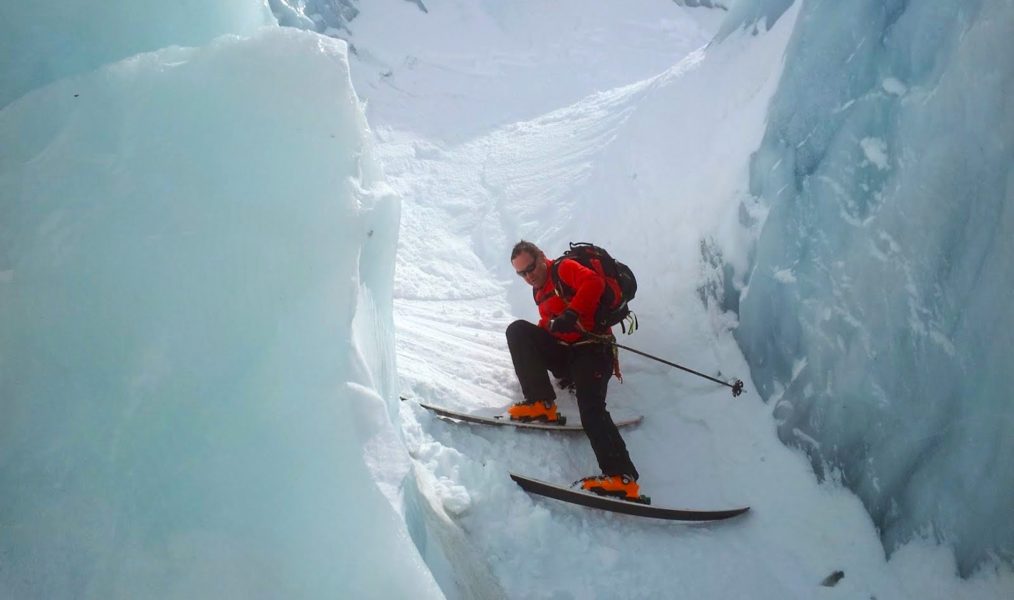‘Avalanche hits forty chalets in Les Houches’, screams the headline of the Dauphiné Libéré, about yesterday’s avalanche into the Chamonix valley, at the foot of Mont Blanc in the French Alps. Fortunately no one was injured, and only relatively minor damage was done to the houses. This was no repeat of the Montroc avalanche of 1999, but only by luck. This area of Les Houches wasn’t zoned as an especially high risk area. Over in Mattertal the valley is similarly blocked, with slides reaching the valley between Tasch and Zermatt. The media is full of references to thousands of holiday makers being blocked into resorts, once in a generation snowstorms, and that word again that I hate to utter; snowmageddon.
You’d be forgiven for thinking that there was nothing to do in the mountains, and that they would be in complete shutdown, but there have been gaps in the weather. Christmas week this year was a marked difference from last year, when there were over twenty trail runners seen on the Vertical Kilometre trail running route between Chamonix and Planpraz. This year saw the best Christmas week piste skiing for several years, so Santa won’t have had to worry about the bases of his sleigh runners for once. Off piste skiing has been a different story, with that recurrent word appearing in every tweet, blog, and post; rocks. The pre holiday season snowfalls were much appreciated, and there were some great powder stashes to ski down from Plan d’Aiguille, and in the Grand Montets trees, as well as across the border in Courmayeur.
Well, that all sounds good so far, so what went wrong? It rained to 2100m altitude during the holidays, and that made for very heavy snow lower down, an avalanche risk at 5/5 for many days, natural purges, and a very busy time for the pisteurs (ski patrollers) and security services. Get ready to snigger, but bird watchers often refer to studying the jizz of an unidentified bird, referring to spotting the unique flying techniques, shape, colours, or habits, to help work out what it is. There is a similar technique for spotting the flying skills of Pascal Brun, the legendary pilot of Chamonix Mont Blanc Helicopters (CMBH), as he twitches the controls effortlessly to ease his helicopter between towering granite needles, to use the bell explosion device to purge controlled avalanches from cornice threatened or snow loaded slopes, to secure the ski areas. Each morning the clatter or his rotor blades has filtered down to the valley floor, as the booms of avalanche blasting echoes around the valley.
The sudden warming temperatures not only affected the skiers, but also the ice climbs which had been forming well, suddenly went out of condition or were affected by avalanche risk on the approach or from above. On many avalanche forecasts as the days progressed, it was possible to see a huge range within a relatively small area, with Switzerland having level 1 through to 5 across the country a couple of days ago. This was such a contrast to the two weeks before Christmas, when there was perfect off piste, with some of the best areas in the Northern Aosta valley of North Italy. New Year week saw several storm cells passing through, and the high rain, allied with wet snow, caused much localised flooding. Much of central Chamonix resembled a slushy swimming pool, with cars stalling in it’s waters, and making progress around town very difficult.
Over the next few days, we are seeing better weather returning to the Alps, with colder overnight temperatures. This will help stabilise the snowpack quite quickly, and you can monitor the avalanche forecasts across the Alps at this website; http://www.avalanches.org/eaws/en/main.php. So the big snow storm has finally blown through, but some of the hurricane winds of storm Eleanor have left their mark. During the storm the winds peaked at over 225km/h, and the vast amounts of snow created a huge ice build up on the hanging pylon of the Mont Blanc Panoramic cable car, in the sector of the Col de Flambeaux, above the Vallée Blanche on its traverse between Aiguille du Midi and Helbronner. This caused damage to the bearer cable, and skiers have been advised to keep clear until works to stabilise it have been completed.
It’s this forthcoming period of stability that is so much being looked forward to. The overnight temperatures being so cold, after a series of so many melt-freeze cycles are going to bring many ice climbs into great condition again. It’s the Val de Cogne that will be where I’m keenest to head in the coming weeks, and also the Kandersteg icefalls. The Vallée Blanche will soon be in good condition, once the ridge is dug out again at the Aiguille du Midi, as it had been equipped before the storms, but since completely buried. Before the holiday period, most mountain guides were limiting the group size to two to three competent skiers for the Vallée Blanche, but now the abundant snow will have filled in many of the crevasses, and improved the snow cover on the Mer de Glace considerably.
During the next days and weeks, we will need to be especially vigilant about the quantity of snow around. The headlines referring to ‘once in a generation’ snowfalls, are actually quite accurate. Many younger seasonnaires may well have never seen these quantities of snow before. As ever the advice is to make sure you are avvy-savvy before you head out. The top ten tips are as follows;
1. Always wear an avalanche transceiver, and carry a snow shovel and probe.
2. Ensure that you check the avalanche forecast every single day, and note critical slopes.
3. Learn how to use your avalanche safety kit. Go on a course, train with others. Practice.
4. Consider the heuristic traps (the group dynamics), and create a safe team atmosphere.
5. When planning a day on the mountains, have several back up options, so you can adapt.
6. Constantly monitor conditions during the day, and adapt to them at every opportunity.
7. Never be proud. If in doubt, stop and talk it through with your group, or call for help.
8. Use your brain as a data logger, monitoring all the warning signs you see, over the day.
9. Being safe doesn’t mean being boring. It means being wise, and choosing wisely.
10. If in any doubt, turn back. There’s no old bold freeriders. Think safe. Stay safe.
It’s okay to admit you are slightly scared by these conditions. Every mountain guide, leader, and instructor is losing sleep at the moment. That doesn’t mean they can’t keep you safe, but this is where they earn every single penny of their pay. Their mind is racing through the situations they have experienced before, and how to adapt to it. You won’t see their fear, as they are highly professional, and will have planned meticulously, to take you to rewarding yet safe areas. There are many areas where you can already find great conditions, and each day ahead seems more stable. That’s where the risk is greatest, when people start to let their guard down, and become complacent. An avalanche risk 3/5 is still considerable, and the sad stats are that most accidents occur when the risk level is 2 or 3. It’s the days ahead where you will learn the most, think the most, and be rewarded the most. Stay safe.
The summary is that it’s an incredibly complex and fast evolving situation in the Alps, with conditions and risks changing on a daily basis. Who knows what the next few weeks will bring, but the key positive is that the freeze-thaw cycles, deep avalanches, and high rain-snow altitudes, will finally have created a heavy but hopefully more secure base. In the next month, I hope to not mention rocks again, unless in the context of winter Alpine climbing.
 Kingsley Jones is an International Mountain Leader and co-owner of Icicle Mountaineering. He’s also an author of mountain running books including ‘Lake District Trail & Fell Running’ and ‘Chamonix Trail Running’. More info at www.kingsleyjones.com
Kingsley Jones is an International Mountain Leader and co-owner of Icicle Mountaineering. He’s also an author of mountain running books including ‘Lake District Trail & Fell Running’ and ‘Chamonix Trail Running’. More info at www.kingsleyjones.com






